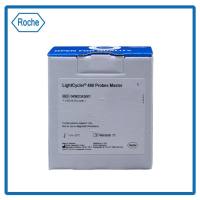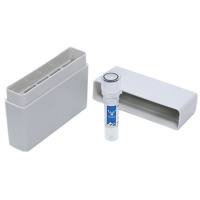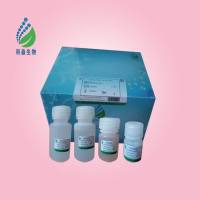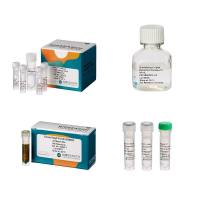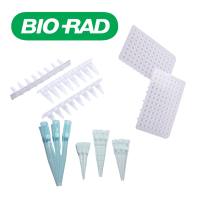IMMUNOSCREENING OF WITH ANTIBODY PROBES
互联网
Adsroption of Anti-E. coli Antibodies
Grow E. coli strain Y1090 in L broth at 37°C overnight. Transfer to 10 mM MgSO4 and store at 4°C for future use. These cells are good for about 1 week.
Soak one 132 mm nitrocellulose membrane per Petri dish in 10mM IPTG (MW=238.31). Briefly blot the excess solution from the filters, and wrap them in cellophane. These should be moist and stored at 4°C.
We typically adsorb serum with five 150 mm Petri dishes of lysed E. coli to reduce anti-E. coli antibody background. These antibodies are present in all human sera, rabbit sera, and rodent sera. For each Petri dish containing solidified LB agar, mix 0.6ml of the Y1090 overnight-saturated culture with 30,000 pfus of lambda-gt11 (diluted in TMG) in glass test tubes and incubate at 37 - 42°C for 15 minutes without shaking.
Plate this mixture with 7 - 7.5 ml top agar per 150 mm Petri dish. Let the dishes sit on the lab bench for about 5 minutes to solidify the top agar. Then transfer them to a 42°C incubator. Check for plaque formation after 3 hours. If plaques are seen, go to step 5 after another 30 minutes (i.e. a total incubation total time of 3.5 hours). If plaques are not seen or are very small, wait another hour before continuing. If no plaques are seen at 4 hours, you probably screwed up the dilution and might as well start over!
Carefully layer a single IPTG-soaked membrane on each Petri dish (avoid trapping air bubbles between the membrane and the agar), and transfer the dishes to a 37°C incubator for 3 hours.
Flip membranes up side down on the dishes and incubate for another 2 - 3 hours.
Remove membranes from plates and wash four times in TBST for 5 minutes each at room temperature.
Block membranes with gentle agitation for 1 hour in a 5% non-fat dry milk solution made in TBST (or block overnight at 4°C).
Wash membranes four times in TBST for 5 minutes each at room temperature.
Dilute serum 1:100 in 3% BSA and 0.02% sodium azide in TBST
Transfer diluted serum in a 150 mm Petri dish. Place one membrane in the serum for 1 hour at room temperature, shaking gently. For 30 ml of diluted serum, we usually adsorb 5 membranes sequentially. Although the background might still be high (E. coli titers vary greatly between individuals), we prefer to do library screenings using partially vs. totally adsorbed serum. With such sera, each plaque is observed, and positive plaques stand out in color intensity against a background of negative plaques. (Note: If the serum is very weak, additional adsorptions may be necessary.) Keep a small section of each membrane in TBST for evaluation after adsorptions. Number each of these sections with pencil indicating the order of adsorption.
Wash the small membrane sections in TBST for 5 minutes, 4 times, at room temperature.
Incubate these membrane sections with secondary antiserum for 1 hour at room temperature (For detecting human antibodies, we use Sigma #A-3150: goat anti-human IgG alkaline phosphatase conjugate, diluted 1:1000)
Wash membranes in TBST for 5 minutes, 4 times at room temperature.
Develop membranes by diluting 33 µl NBT and 66µl BCIP in 10 ml of alkaline phosphatase buffer. Soak membrane sections in this solution for 5 - 10 minutes while mixing. Keep this mixture under foil to reduce exposure to light.
Library Screening:
Once the serum is sufficiently adsorbed, a lambda-gt11 library is screened as described above, except that step 6 is omitted, and the entire membranes are developed in steps 12 �15. Number each Petri dish and membrane using a "Sharpy" or a pencil). After placing the membranes on their respective plates, stab quickly through the membrane to the bottom of the agar with a 25g needle dipped in India ink in three asymmetrical positions. This allows you to align the positive plaques on the membranes with the appropriate region of the agar plates to pull the plaques after developing. We usually develop 3 - 4 membranes at a time, using fresh developing solution for each batch of membranes. (Make 20 - 25 ml of solution for a library screening of 7 - 10 plates). Do not rotate the filters too fast in the developing solution or centrifugal force will exclude the solution from the center of the filters and produce uneven staining. Also, if 4 or more membranes are being developed at a time, rearrange the order once or twice during developing to insure even exposure of all membranes to the solution.
RECIPES
L Broth (LB; Luria-Bertani)
10 g tryptone
5 g yeast extract
5 g NaCl
1 liter water
Autoclave
IPTG (100mM)
23.8 mg per ml autoclaved water.
Weigh out approximately this amount; note the amount weighed and dissolve in the appropriate volume of autoclaved water. Store at 4°C.
TBST (10 mM Tris-HCl, 0.15 M NaCl, 8 mM sodium azide, 0.05% Tween-20, pH 8.0)
For 4 liters For 500 ml
4.84 gTris 0.61 g Tris
35.06 g NaCl 4.38 g NaCl
2.0 g NaN3 500 µl 10% NaN 3
2.0 ml Tween-20 250 µl Tween-20
pH to 8.0 with HCl, QS with water, and store at 4°C.
NBT Stock Solution
50 mg/ml in 70% dimethylformamide.
Store in a foil wrapped bottle at 4°C.
BCIP Stock Solution
12.5 mg/ml in 100% dimethylformamide.
Store in a foil wrapped bottle at 4°C.
(85% dimethylformamide also works fine to dissolve the BCIP).
(Promega sells the NBT & BCIP solutions both @ 50 mg/ml & suggests using 66µl NBT and 33µl BCIP per 10 ml buffer. Both protocols work fine.)
Alkaline Phosphatase Buffer
100 mM Tris-HCl, pH 9.5
100 mM NaCl
5 mM MgCl2


